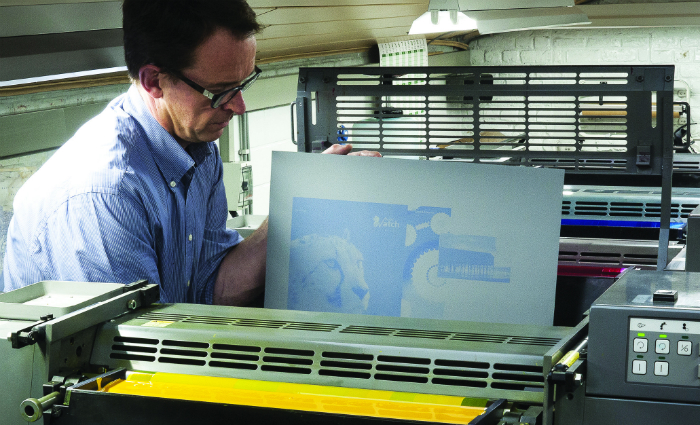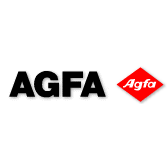
What does the plate do?
Azura TE is an offset litho plate for thermal laser imaging and on-press activation. No separate chemical processors, gum unit or other off-press activation is needed, so the imager can be very compact. Agfa says without liquids or waste to worry about, you can even put the imager in an office.
It is intended for most sheetfed offset litho presses running standard inks, with particular focus on the B2 sector, though B3 and B1 sizes are available. Run lengths up to 75,000 impressions can be achieved (unofficially, perhaps 100,000), but the latex coating means you can’t bake it for even longer runs.
When was it launched and what market is it aimed at?
It was launched at the beginning of 2015, as an alternative to Agfa’s established Azura TU, which requires a separate gumming unit for activation before going on the press. Unlike the TU plate, TE plates are only intended for sheetfed presses, so are aimed at printers who are very tight on space, or who are already using processless plates from other manufacturers that don’t need a gumming unit.
How does it work?
Imaging is handled conventionally by a thermal laser platesetter in the 830nm range. The coating is the latest version of Agfa’s Thermofuse technology, first introduced in 2004. The plate can be handled in full daylight (for up to 24 hours). The plate base is conventional grained and anodised aluminium. The single-layer TE coating contains ink-accepting latex pearls that fuse and bond to the aluminium base when they are hit by the laser.
A thermochromic dye shows the imaged areas with a strong contrast that’s enough to measure on a plate reader or densitometer. Images are said to be sharp, with little dot gain and excellent reproduction of fine serif text, both positive and negative.
Once on the press, the action of the fountain solution and ink breaks down and removes the non-image coating as the first few sheets are run. The debris is deposited on the blanket then onto the first few running sheets and by the tenth it can be printing a sellable sheet. There is no contamination to the fount solution and the only adjustments to be made are to pre- and post-damping.
How does it differ from previous products?
The major difference is that no gumming unit is used. Agfa says: “The TE plate is almost a niche product, mainly for B2 printers using 600-800 plates per month, who may not have room for a gum unit. Other customers may already use on-press plates from other suppliers, so it gives them the opportunity to switch.”
What imagers can be used?
Agfa supplies its own platesetters and like any plate supplier it is amenable to making good deals on hardware. Third-party external drum 830nm thermal laser platesetters can also be used, as long as Agfa has accredited them to work with the plate. In jargon terms the plate is sensitive to 160mJ/sq cm, so if your platesetter delivers at least that, chances are it will work.
What is the USP?
According to Agfa a combination of the strong visible image, the resolving power of the coating (1 per cent to 99 per cent dots and sharp edges) and the on-press performance.
How easy is it to use?
As ever, it is said to be very easy. In particular the lack of requirement for chemical or other activators and gummers means there is less to go wrong, with no chemicals to refill, clean up or dispose of. The plate can be handled in daylight and can be taken straight from imager to press.
How much does it cost?
Agfa won’t give prices, which depend on volumes and whatever deals the printer can negotiate. ‘Competitive’ is the most they will say.
The alternatives
FUJIFILM BRILLIA HD PRO-T3
The third generation of Fuji’s processless Brillia HD Pro-T plate features a new micrograining technology and a new three-layer coating which is claimed to allow faster on-press activation and wider tolerance of press conditions, inks and fount solutions.
Sizes Standard formats
Gauges 0.15mm, 0.20mm, 0.30mm
Platesetter compatibility 800– 850nm thermal laser
Sensitivity 120mJ/cm2
Resolution 1%-99% dots
FM capability 20 microns
Daylight resistance White light 400lux for two hours
Max run length 100,000
Contact Fujifilm www.fujifilm.com.au
KODAK SONORA XP
This versatile processless plate has a twin layer photopolymer type coating and can be used for web or sheetfed presses with heatset or UV inks. There’s also a News version for newspapers including coldset.
Sizes Standard formats
Gauges 0.15mm, 0.20mm, 0.40mm
Platesetter compatibility 800- 850nm
Sensitivity 150mJ/cm2 with Kodak Squarespot platesetters, 175mJ/cm2 with others
Resolution 1%-99% dots at 200lpi
FM capability 20 microns
Daylight resistance 1 hour white light, 8 hours UV-cut, 24 hours yellow light
Max run length 200,000
Contact Kodak www.kodak.com.au
Specs
Sizes: 2-up, 4-up and 8-up formats
Gauges: 0.15mm, 0.20mm, 0.24mm, 0.30mm
Platesetter compatibility: 830nm external drum
Sensitivity: 160mJ/cm2
Resolution: 1%-99% dots with 240lpi Sublima AM screens
FM capability: 20 microns
Daylight resistance: Up to 24 hours
Max run length: 75,000 impressions (conventional inks), 8,000 (UV inks)
Post bake: Not possible
Shelf life: 18 months
Contact: Agfa Oceania www.agfagraphics.com
Comment below to have your say on this story.
If you have a news story or tip-off, get in touch at editorial@sprinter.com.au.
Sign up to the Sprinter newsletter

